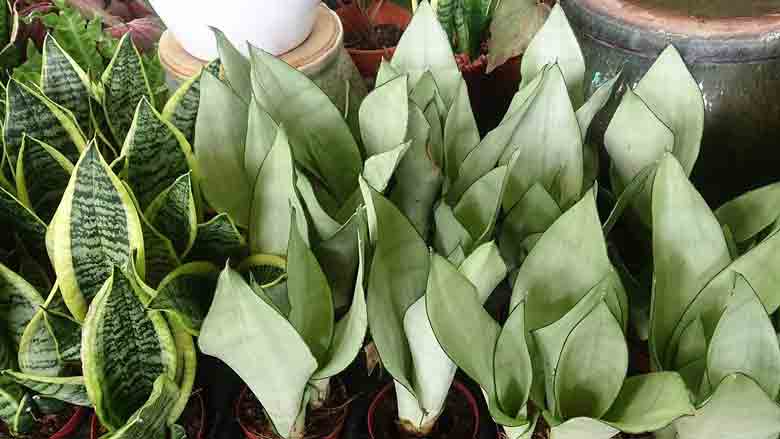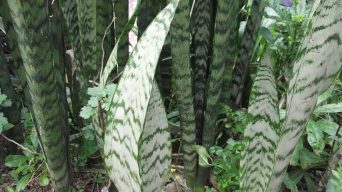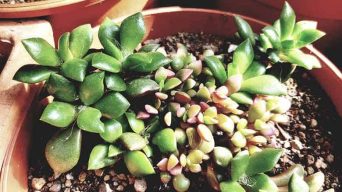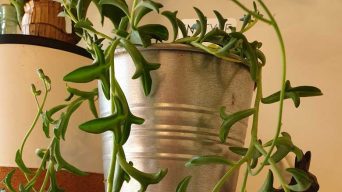Succulents are very popular houseplants, and the Sansevieria Moonshine succulent plant is no exception.
Thanks to its attractive leaves and easy care requirements, it’s one of the most popular varieties of this plant species.
The Moonshine Sansevieria is an excellent option if you’re looking for a low-maintenance succulent to add to your home.
In this article, we’ll provide care instructions for this plant and show you how to propagate it so you can enjoy it for years to come.
Overview
The Sansevieria moonshine is a cultivar of the West African native Sansevieria trifasciata (dracaena trifasciata), known as the snake plant.
The characteristic silver-green leaves have faint dark green lines along their length and can grow up to 2 feet (61cm) tall.
The Sansevieria moonshine is also known as:
- Moonlight Sansevieria
- Silver Moonshine
- Moonshine Snake Plant
- Moonlight Snake Plant
- Silver Snake Plant
- Sansevieria Futura Silver Offset
- Sansevieria trifasciata ‘Moonshine’
How To Care for Sansevieria Moonshine
Sansevieria Moonshine care is easy and relatively low maintenance.
Below, you’ll find the most important information you need to know about caring for
Sansevieria Moonshine snake plant.
Sun Exposure & Light Requirements
Sansevieria Moonshine succulent plants do best in bright indirect light. While they can withstand some direct sunlight, excessive exposure may lead to the succulent leaves taking on a yellow hue.
Moonlight Sansevieria plants need six hours of bright light per day.
If you’re keeping your Moonshine Sansevieria succulent plant indoors, place it near a west or east-facing window that receives plenty of natural indirect sunlight during the day.
If you’re keeping your Moonshine snake plant outdoors, move it to a spot that receives partial sun during the morning or late afternoon hours.
Too much direct sunlight can cause your succulent to sunburn.
Watering Requirements
Sansevieria Moonshine succulent plants are drought-tolerant and can go for long periods without water.
However, to keep them looking their best, it is recommended to water them when the top inch of soil becomes dry.
If the plant is kept in a pot with a drainage hole, water until the water drains out of the pot.
If the plant is not in a pot with a drainage hole, water until the top inch of soil becomes moist, then wait until the top inch of soil dries before watering again.
In general, Sansevieria Moonshine plants need to be watered about once a week.
Soil Requirements
Sansevieria Moonshine succulent plants do best in a well-draining soil mix.
A cactus potting mix or a succulent mix will work well.
You can also make your own mix by combining two parts of potting soil, 1 part coarse sand, and 1 part perlite.
The soil needs to be well-drained so that the roots can dry between waterings and retain some moisture.
If you tend to overwater your plants, adding pebbles or rocks at the bottom of the pot might be a good idea to give the roots some air so they can dry between waterings.
Temperature and Humidity
The temperature range in which Sansevieria Moonshine plants thrive is 68° to 80° Fahrenheit, or 20 to 27 degrees Celsius, during the day and 50° to 70° Fahrenheit, or 10 to 21 degrees Celsius, at night.
They cannot tolerate high humidity, moisture, or frost.
To keep your Sansevieria healthy, monitor the humidity levels in your home and make sure they are low to moderate.
If the temperature or humidity is too high, your plant will begin to wilt or curl its leaves, which is a sign of stress.
Fertilizing
The Moonshine Sansevieria Moonshine plant is a very low-maintenance plant.
It can survive without ever being fertilized, but it will grow much better if you feed it every month during the growing season of spring and summer.
Use a balanced liquid fertilizer diluted to half-strength, and apply it to the soil around the plant.
Take care not to over-fertilize the plant, as this might cause root rot or damage to the leaves.
Potting and Repotting
When the Moonshine Sansevieria plant grows too large for its pot, it must be transplanted into a larger one.
You will want to transplant when the root system is crowded (roots growing out of drainage holes) or pot-bound, which you can recognize by soil that does not drain well and remains wet between waterings.
Transplanting is best done in the spring or summer when the succulent is in a growth spurt.
To transplant, gently remove the succulent from its pot. If the succulent is pot-bound, you may need to break up the soil using your hands. Be careful not to damage the roots in the process.
Repot the succulent into a container slightly bigger than its original, and ensure to fill the space around the roots with fresh soil.
Use a pot with drainage holes since the Moonshine snake plant is susceptible to root rot.
Pruning
Moonshine Sansevieria succulents do not require pruning.
However, if you have a Silver Moonshine plant that is not growing well or has yellow leaves, pruning can help to remove dead or dying plant matter and may help the plant to grow better.
Removing damaged or dead leaves can help keep your Moonshine Sansevieria looking good and prevent diseases from spreading.
To prune Moonshine Sansevierias, use sharp, clean shears to cut the leaves off at their base; make sure not to damage any healthy tissue surrounding the leaves.
Pests and Diseases
Pests usually leave Sansevieria Moonshine succulents alone, but sometimes mealybugs or spider mites may appear.
Mealybugs are tiny, white, cottony pests that can be removed with a cotton swab dipped in alcohol.
Spider mites are tiny red or yellow bugs that can be controlled with water mixed with dish soap weekly.
Moonshine plants may occasionally suffer from root rot caused by overwatering or poor drainage.
Signs of root rot include wilting leaves and soft, blackened roots.
To prevent root rot, make sure the pot has good drainage and do not water the plant too often.
How to Care for Sansevieria Moonshine in Winter
Sansevieria Moonshine care in winter is straightforward.
All you need to do is make sure that the succulent plant is in a bright spot and keep the soil moderately dry.
You may also want to reduce the watering frequency if your home experiences colder temperatures during winter.
The Silver Moonshine is not a cold-hardy plant and will suffer damage when temperatures drop below 32°F (0°C).
If you want to protect your plant from the winter cold, it is advisable to keep the succulent indoors during harsh winters or at least move it out of the cold draft once the temperature drops.
Keep your Sansevieria Moonshine plant in a bright spot and water it sparingly during the winter months to ensure that it stays healthy and happy.
How To Propagate Sansevieria Moonshine
Sansevieria Moonshine plants can be propagated by division or leaf cuttings.
Division
To propagate Sansevieria Moonshine by division:
- Remove the plant from its pot.
- Separate the plant into individual sections using a sharp knife or pruning shears. Make sure each section has at least one healthy root system.
- Replant the divisions in fresh soil and water well.
- Keep the new plants in a warm and brightly lit area.
Leaf Cuttings
To propagate Sansevieria Moonshine by leaf cuttings:
- Cut a healthy leaf from the mother plant using sharp scissors.
- Remove the lower third of the leaf, including the stem.
- Place the cutting in a dry, warm place and allow it to callus over for a few days.
- Plant the cutting in fresh soil and water well.
- Keep the new plant in a warm and brightly lit area.
Leaf cuttings should be taken from healthy, vigorous plants to ensure successful propagation.
The new plants will be ready to transplant into their own pots once they have developed a few healthy leaves.
Sansevieria Moonshine care is the same for both division and leaf cuttings.
These new plants will need plenty of light and only occasional watering until they are established.
After that, you can treat them as you would any other Sansevieria.
Final Thoughts
Succulents are beautiful, easy to care for plants that are perfect for beginners.
The Sansevieria Moonshine is no exception and is an excellent option for anyone looking for a low-maintenance, drought-tolerant succulent.
With a little bit of care, you can have this beautiful plant thriving in your home or garden for years to come.







